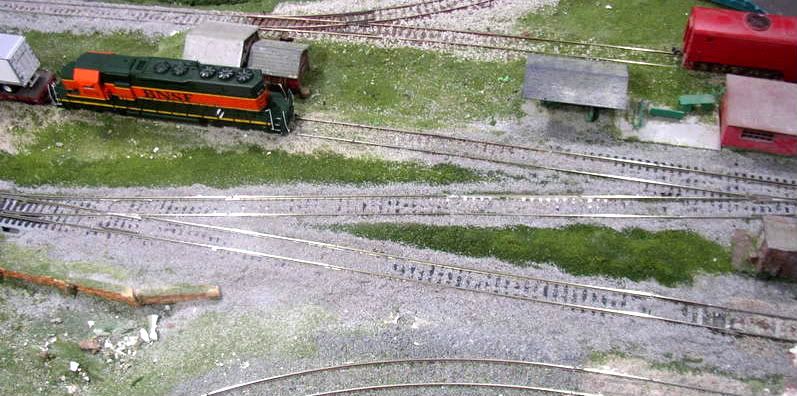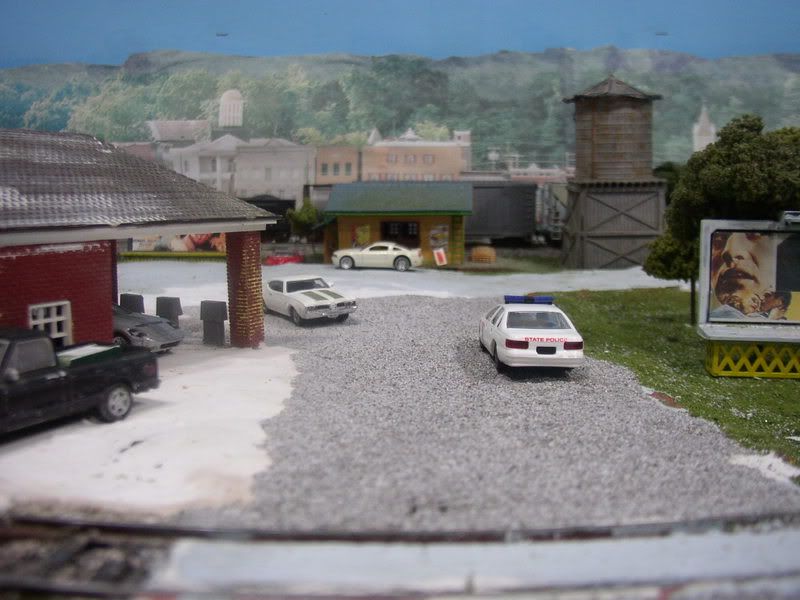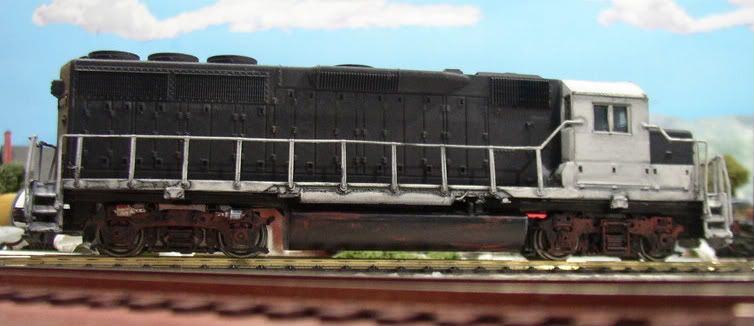Weekly Foto Phun 10/10-10/16
- Thread starter jesso
- Start date
You are using an out of date browser. It may not display this or other websites correctly.
You should upgrade or use an alternative browser.
You should upgrade or use an alternative browser.
C
Catt
This'n is the running mate to the B&O unit I posted on page 4 last week

This is the b unit that will go between them.

Current paint scheme plan is ACL purple and silver.

This is the b unit that will go between them.

Current paint scheme plan is ACL purple and silver.
Chessie: I immediately recognized the name on the building the Pinto is parked in front of. I learned a lot from Wayne.
Thanks, Charlie. Some of the diesels are gone, but I still have 9 left that need new homes. I may put them in the Buy & Sell Forum when I get back from vacation, or I may just take them to the LHS. At least most of the '50s/'60s freight cars are gone, although I did keep quite a few that I plan to repaint and then letter with older-style lettering. Including some replacements for stuff sold, probably about 80 cars to do or re-do, plus a dozen or so locomotives at some phase of re-building. I'll be glad to get them done, then get back to work on the layout.:-D
Wayne
What do you have left Doc?
Hmmmm, we bought a new camera today and I thought I'd play around with it and see how it worked. First up, a shot down Turtle Lane just as the steamer thunders through.

It appears I need to play some more with the foreground focus.
Next up, I thought I'd share some extreme closeups of projects which I hope to make some headway on this week -
My HOn3 gondola needs some grab bars and other detailing...

Here are a couple shots of my two structures from Mooreway...

I'm not entirely tickled with the yellow and may change it to white with brown trim like the one below. This little building is a whole whopping 1-1/8" by 7/8"!

This kit did not come with porches and so I decided to add some. I'm also not happy with the roof and still need to give it some attention like the little yellow building above.
Last up, I found this roundhouse at a swapmeet for $5. I've been wanting to experiment in this area for a while now but as you can tell by the layer of dust on the turntable, I have not been able. The roundhouse will undergo severe modifications. First, if you can't tell, the roundhouse was built for a bigger turntable. I've got an idea on how to fix that though. Second, I plan on hacking the rear half off as there will be a mountain directly behind the roundhouse and I don't have room for the whole thing. I'll try and document this area as I proceed.

Seeing these pictures has shown me that if I continue to take pictures this close up, I am going to have to take my detailing to a whole new level.

It appears I need to play some more with the foreground focus.
Next up, I thought I'd share some extreme closeups of projects which I hope to make some headway on this week -
My HOn3 gondola needs some grab bars and other detailing...

Here are a couple shots of my two structures from Mooreway...

I'm not entirely tickled with the yellow and may change it to white with brown trim like the one below. This little building is a whole whopping 1-1/8" by 7/8"!

This kit did not come with porches and so I decided to add some. I'm also not happy with the roof and still need to give it some attention like the little yellow building above.
Last up, I found this roundhouse at a swapmeet for $5. I've been wanting to experiment in this area for a while now but as you can tell by the layer of dust on the turntable, I have not been able. The roundhouse will undergo severe modifications. First, if you can't tell, the roundhouse was built for a bigger turntable. I've got an idea on how to fix that though. Second, I plan on hacking the rear half off as there will be a mountain directly behind the roundhouse and I don't have room for the whole thing. I'll try and document this area as I proceed.

Seeing these pictures has shown me that if I continue to take pictures this close up, I am going to have to take my detailing to a whole new level.
C
Catt
KP&W covered hopper 28755 headed to Gilbert Grains elevator on the tail end of a GVR grain special.


N
nachoman
Jeff, that billboard on the right seems like a good place for that trooper to set up a speed trap, especially if the gas station on the left sells doughnuts 
Kevin
Kevin
Sorry Jeffrey but I dont think we know the same person..This was named after my buddy Steve.Chessie: I immediately recognized the name on the building the Pinto is parked in front of. I learned a lot from Wayne.
Ok. I was thinking of Wayne Wesolowski. He's written quite a few books on model railroading and has several videos available from Kalmbach Publishing. One of the videos I have is the Basics of Model Railroading. I picked it up back in the mid 80's. He has two sons, Tony and Steven.Sorry Jeffrey but I dont think we know the same person..This was named after my buddy Steve.
If you need masking tape of a particular width, simply cut it to suit from a wider tape.
To do this, peel off a suitable length and place it, sticky side down, on a clean sheet of glass. Use a straightedge to ensure that it's placed straight on the glass, with no curves or wiggles. Using a fresh blade and a steel straightedge, trim one or both of the factory edges - these often become nicked and dinged by handling, and also pick up dust and fuzz from the air. Also, if the roll has been sitting around for some time, the adhesive along the edges tends to dry out somewhat, leaving the edges less sticky than they should be for a good seal along the masked line. Working from the trimmed edge, use dividers to mark off the required width(s), then a sharp blade and straightedge to make the cuts. You can also layer the lengths of tape on the glass before trimming, allowing you to cut multiple strips with a single pass of the blade.
Wayne
To do this, peel off a suitable length and place it, sticky side down, on a clean sheet of glass. Use a straightedge to ensure that it's placed straight on the glass, with no curves or wiggles. Using a fresh blade and a steel straightedge, trim one or both of the factory edges - these often become nicked and dinged by handling, and also pick up dust and fuzz from the air. Also, if the roll has been sitting around for some time, the adhesive along the edges tends to dry out somewhat, leaving the edges less sticky than they should be for a good seal along the masked line. Working from the trimmed edge, use dividers to mark off the required width(s), then a sharp blade and straightedge to make the cuts. You can also layer the lengths of tape on the glass before trimming, allowing you to cut multiple strips with a single pass of the blade.
Wayne
Jeff, that billboard on the right seems like a good place for that trooper to set up a speed trap, especially if the gas station on the left sells doughnuts
Kevin
sign1sign1sign1sign1
If you need masking tape of a particular width, simply cut it to suit from a wider tape.
To do this, peel off a suitable length and place it, sticky side down, on a clean sheet of glass. Use a straightedge to ensure that it's placed straight on the glass, with no curves or wiggles. Using a fresh blade and a steel straightedge, trim one or both of the factory edges - these often become nicked and dinged by handling, and also pick up dust and fuzz from the air. Also, if the roll has been sitting around for some time, the adhesive along the edges tends to dry out somewhat, leaving the edges less sticky than they should be for a good seal along the masked line. Working from the trimmed edge, use dividers to mark off the required width(s), then a sharp blade and straightedge to make the cuts. You can also layer the lengths of tape on the glass before trimming, allowing you to cut multiple strips with a single pass of the blade.
Wayne
Now that is a useful bit of information Wayne :mrgreen: :mrgreen: :mrgreen:
Hmmmmmm, this gives me an idea, get some yellow and white Electrical Tape and cut road and lane markings out of them :mrgreen: :mrgreen:. Ive tried other stuff that i bought from hobby shops (cant recall the MRF's name, but i used them on my CAT Rental Module) and it sticks for a day or so and then peels up in some spots, this is after i have completly wiped down the area and let it dry for the best and most ideal sticking surface lol. They just dont work, and for $8.00 a sheet, you think they would
Im going to try the Electrical Tape thing out using Wayne's tip :thumb: :mrgreen:
Josh, most tape "loses its grip" before too long, and I think that electrical tape applied flat (as opposed to wrapped around a wire) will fail, too. Why not use masking tape to mask the road for application of an actual painted stripe. You can make broad curves with the tape as it comes, or trim it into narrower strips for really tight curves and corners.
Wayne
Wayne














